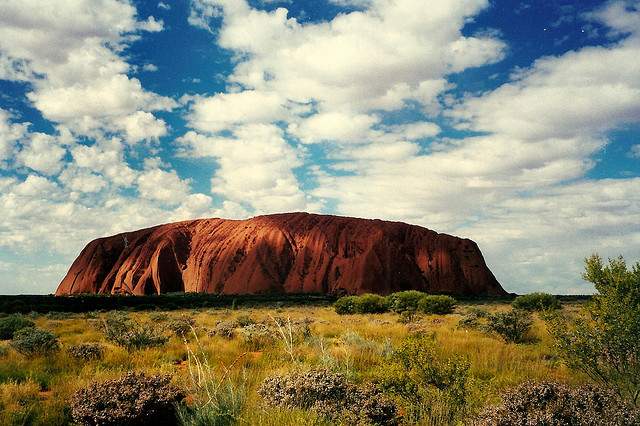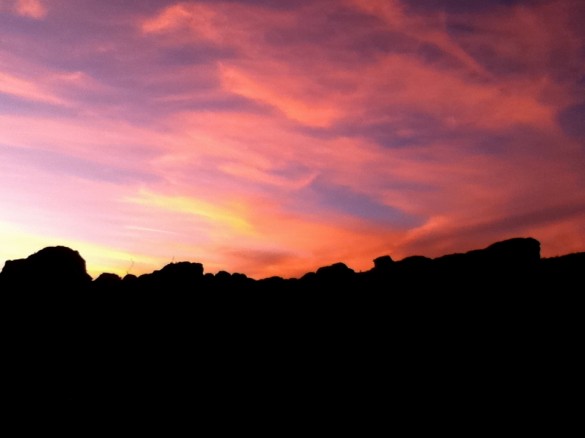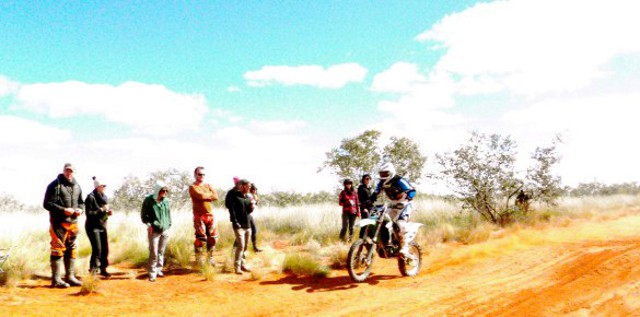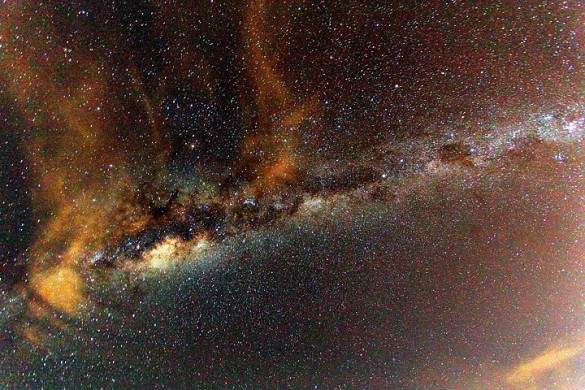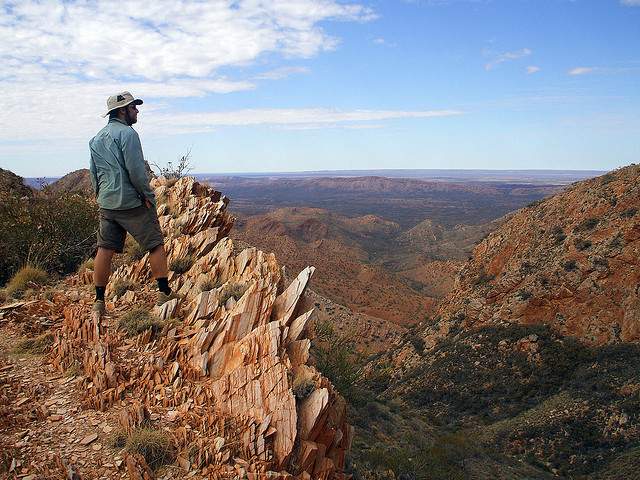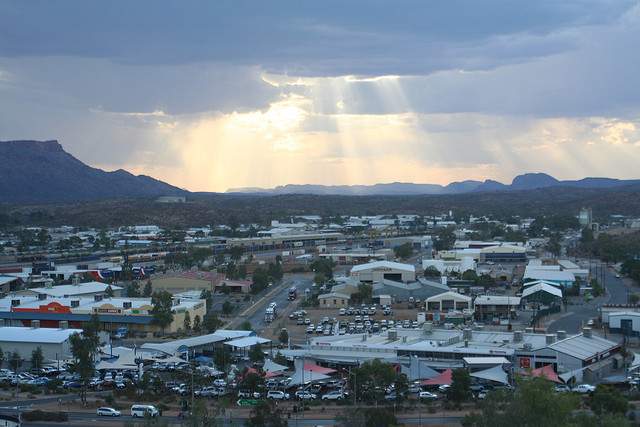When a newcomer first sets foot in Alice Springs, the heart of Australia’s outback, they are often greeted by the saying: “If you see the Todd River flood three times, then you’re a local”. After living and working as a tour guide in Alice Springs and watching the sandy Todd flood three and a half times, I now call myself a local and can pass on a couple of the best kept secrets!
[social]
Don’t be a fool-a-roo at Uluru
It doesn’t matter how many images you have seen of Uluru, nothing prepares you for the first time you glimpse the red rock rising above the desert dunes. Not only is it the crown jewel of Australia’s outback, but one of the most sacred and spiritual places for the Anangu, the Aboriginal people of the region. As you walk beside its towering walls, stop and look around. You are surrounded by the evidence of the Aboriginal Tjukurpa creation stories passed down for tens of thousands of years. There are no two identical views of Uluru, especially once you begin to see it through the eyes of the Anangu.
The play of light upon Uluru’s surface brings out the many moods of the rock, making an Uluru sunset and sunrise a highlight of any visit to Uluru Kata Tjuta National Park. Sunset is enjoyed at one of the main sunset viewing areas marked within the park. Just as the sun pauses above the horizon, Uluru momentarily forgets its role as a rock and lights up like a cloud, illuminating pink before shifting to a deep blood red. Unfortunately, the surrounding circus of similar-minded visitors can often hamper the experience as they jostle to capture their memories on film. Sunrise, if taken from the sunrise viewing area, is a similar affair but with the added hazard of negotiating the many ‘I’m not a morning person’ stalking around due to the early hour.
Local tip: For a unique and equally beautiful sunrise, head back to the sunset viewing area and let the emotion of the morning sky take the lead as the pre-dawn colors cast a silhouette around the rock. You will find the sunset viewing areas almost always deserted, but you must arrive as the park opens as the time before sunrise is when the show is at its best.
The king of the canyon sunrises
An often by-passed wonderland of the red center, Watarrka, or King’s Canyon, is a snapshot into the prehistoric land. As you stand atop the shear walls that have been carved by a 300-million-year-old clash against the elements, you discover marine fossils, feathery cycads, and concealed reptiles amongst the many rocky outcrops. A Kings Canyon sunrise is one of the most popular ways for people to experience the canyon as it enables you to do the main Rim Walk in the cooler morning hours. Sunrise for the masses means standing at the base or just atop the north or south walls of the canyon, as these are the most easily accessible locations.
Local tip: The best viewpoint can be found just 40 minutes from the top of the rim and only a little off the beaten path at the isolated but historic Cotterill’s lookout, named after the father and son duo who opened up the canyon to tourists. Here you are alone as you sit perched upon the dome stacks of the canyon. Watch as a gentle tide of golden light creeps towards you in the moments before the sun pierces the rim of the canyon. It feels as if you are atop of the world and witnessing the first sunrise to ever light the ancient land. You will want to arrive at the base of the canyon at least 50 minuets before sunrise, so you may need to awaken a little earlier.
Finke
If a unique and slightly out of this world outback experience is what you are after, then Tattersall’s Finke Desert Race is an absolute must. Finke, as the locals call it, started in 1976 as a 460 km there-and-back challenge for local motorbike riders that snakes along the red sand of the Old Ghan Railway service track from Alice Springs to the Aputula Community. Today the race includes quads and buggies, is heralded as one of the biggest sporting events in the Northern Territory and is known in Off Road Racing circles as one of the richest, most difficult and remote courses in the world.The race is held over the long Queen’s birthday weekend each June.
Locals move in on the Saturday afternoon to resurrect last year’s camp, with territory lines often reinstated weeks in advance. You are not just a spectator to the race here, you are practically part of it. Half the experience is in constructing your makeshift shanty town, then exploring the desert metropolis as it grows amongst the dunes and spinifex.When darkness falls, the carnival begins and the boundaries between camps dissolve. A night of true outback partying, or at least campfire bonding begins. It does not matter who you are, where you come from, or what you believe, at Fink you are here to forget and have fun. As the morning light hits the remains of the previous night, the silence is shattered by the thunderous judder of helicopter blades cutting through the air, scouting the racetrack to ensure it is clear. It is then that you realize you have practically been sleeping on the track. As the roar of the helicopter descends beyond the horizon it is replaced by the screech of motorbikes as they come flying down the track, the buggies and quads in hot pursuit. The Finke Desert Race cannot be adequately described by words, as it is an overwhelming assault on the senses that can only be experienced to be understood.
Local tip: Camping at Finke is by gold coin donation, with detailed information on the upcoming race found at the events’ website. To get the real Finke experience you must camp trackside, close to the insanity.
Under the milky way
To follow in the footsteps of explorer John McDouall Stuart, the first to cross Australia from south to north, is one of the best ways to experience the outback. Not much has changed in the last 150 years as the Devils Marbles, a cluster of curious boulders playfully scattered along either side of the Stuart Highway, demonstrate. Most bypass the impossibly balanced rocks of Devils Marbles Conservation Reserve or pause only briefly in their journey to take a photo, not realizing that the outback sun bleaches the subtle rust colorings of the marbles. An overnight stop should be worked into the itinerary, as sunset and sunrise are when this landscape comes alive.
Local tip: The modest overnight campsite at Devils Marbles, situated just off the Stuart Highway, provides a beautiful location to sleep under the twinkling Milky Way, just as Stuart and his expedition would have done in 1861. A visit to the red center cannot be complete without an open-air slumber party as the outback has one of the best night skies in the world – you are guaranteed to see shooting stars! As the glow from your campfire is slowly replaced by darkness, you can snuggle down into your swag and watch the heavenly games unfold across the sky. With the coming of daylight you are treated to the colors of sunrise from the comfort of your swag; the morning light plays upon the marbles surface bringing forth the shades hidden in the peak of the day. The Devils Marbles campsite is run by a $3 donation honor system.
A walk on the wild side
Lose yourself as you lose the world by taking a walk on the wild side along the Larapinta Trail, an epic 223 km trek that snakes its way along the rugged ridge-lines of the West Macdonnell Ranges. The isolation of the trail makes it one of the most intimate ways to experience the real outback and is not only one of the best treks in Australia but also the world. It is one of the few treks that is set entirely in an arid zone. Comprised of 12 stages, the Larapinta Trail was designed to link the hidden oases of the West Macdonnell Ranges. By scaling the backbone of the rocky outcrops, panoramic views of the surrounding floodplains are laid at your feet. You escape from the exposed peaks down into sanctuaries like Ormiston Gorge and Standly Chasm where the rare Rock Wallaby or a lone Dingo may be spotted amongst the scrub. Tracing along dried riverbeds, you cut through the ranges to hidden waterholes like Ellery Creek Bighole and Redbank Gorge.
The untouched and remote arid zone landscape that makes the Larapinta Trail so unique does mean that it is a highly challenging journey, a definite walk on the wild side rather then a stroll in the park. Safety is the highest priority and is your responsibility.
Local tip: Open from April until October, the division of the track into 12 sections allows for some flexibility to cater to varying walking abilities as the more strenuous sections of the walk can be bypassed. Completion of the entire trail takes an average 19 days with several companies operating out of Alice Springs to assist Larapinta Trail hikers. The Larapinta Trail is unlike any other outback experience but comprehensive planning must be taken before commencing the trek.
Tips for surviving in Alice Springs
The remote city of Alice Springs is the perfect place to use as a base for exploring Australia’s outback as it is literally located in the center of the country. The most important thing to note is that the outback is an extreme place, with temperatures soaring above 40 degrees Celsius (104F) in the summer and plummeting below minus 6 degrees Celsius (21F) during the winter months.
The best time to visit is the shoulder seasons, mid March to mid May and mid August to mid October, when the days are hot and the nights are cool. Due to the remote location of Alice Springs, traveling there can be time consuming and costly, so planning is recommended. Flights depart daily to Alice Springs airport from most capital cities across Australia, with booking in advance an easy way to help lower the cost. For the budget traveler, Greyhound offers a service running from Darwin, Adelaide and Cairns, with connections to other destinations across the country. For those who wish to see the Australian outback in comfort rather then from the bumpy seat of a camper van, the Ghan Railway closely follows the Stuart Highway and is one of Australia’s great railroads.
A popular choice with backpackers is to hire a camper van and embark upon the 3000 km road trip along the Stuart Highway from Darwin to Adelaide, with Alice Springs as the half way point. As Alice Springs is a tourist town it is well equipped to host all from the wayward backpacker to the comfort holiday maker. Backpacker, budget accommodation and couch-surfing can be booked on the Internet with prices ranging between $20 to $50 AUS per night. For more up market accommodation, prices generally range between $100 to $200 AUS per night.
If you are traveling with a vehicle, there are a number of caravan parks which offer unpowered or powered sites for $30 to $40 AUS per night. Free overnight roadside camp bays are also located at regular intervals along the length of the Stuart Highway, several within a 100 km radius of Alice Springs. Despite its small size and remote location, Alice Springs offers a variety of restaurants, eating options and night life to keep both the locals and visitors entertained. Around the Todd Mall, Todd street and the center of town a number of restaurants, cafes, and pubs can be found offering a selection of affordable dishes from local specialities like kangaroo burgers and camel pie, to Thai, Italian, and Indian cuisine. Supermarkets and corner stores are also available for those on a very tight budget. A journey into Australia’s outback is definitely worth the extra effort it takes to reach the remote desert heart of the country and gain a glimpse into the ancient land and its culture.
Read more about traveling in Australia’s Northern Territory:
- Book an adventure trip in Australia
- Check out hostels in Alice Springs
- Read Australia’s Northern Territory: 10 Things Not to Miss
Photos by: TheCreativePenn, Photos 2 and 3 – courtesy of the author and may be used without permission, Shaun Mittwollen, andydolman, Stephen Barnett.
